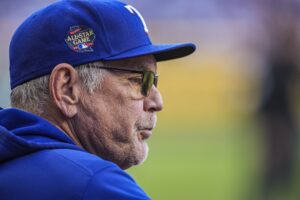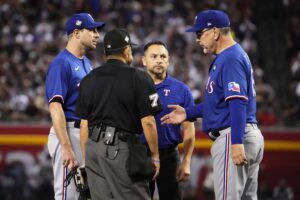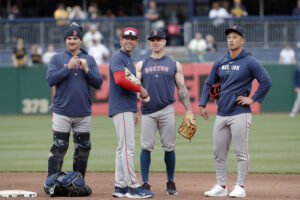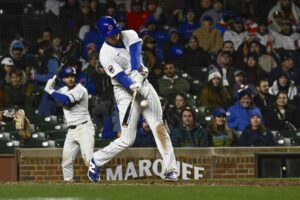The thought sounds ludicrous at face value, I know. Barry Bonds won seven National League MVPs and has hit more career homers than there are words in this article. Anthony Rizzo is just 27 years old and is a really good player in 2016. He has less than 200 career homers and has finished in the top-10 in NL MVP voting twice. To see this comparison, we have to commit baseball heresy and go beyond the numbers.
Anthony Rizzo: A Modern Day Barry Bonds
The Home Run King
First let’s look at what made Bonds the hitter that he was (whether or not you believe it was PEDs is irrelevant here, we’re simply looking at mechanics and approach). During his career, Bonds was about as atypical of a power hitter as one could be in the era in which he played.
For starters, he choked up on the bat. A concept that is widely believed to zap a hitter’s power, it became a tool for him to generate unearthly bat speed. He was very compact and simple in his approach and that allowed him to not only hit for power, but hit for a high average. He didn’t simply use his strength and momentum of the bat to generate power. Instead, he kept 100 percent control of the bat through the zone and hit the ball on the “sweet spot” about every single time (which is just as mind-boggling as it sounds).
The Evolution of Rizzo’s Swing
In 49 games with the San Diego Padres in 2011 he hit just .141. His swing was long and unbalanced, which most certainly led to his struggles with San Diego. Rizzo also did that thing where hitters put their pinky finger over the knob of the bat, which is all well and good if you’re hitting .280 with 30 homers, but will be looked at as one of the first problems if you’re struggling.
After the 2011 season, he was traded to the Chicago Cubs. A new team and fresh start did wonders for his career. After a drastic overhaul of his mechanics, he led the Pacific Coast League in homers (23), slugging percentage (.696) and OPS (1.101) before being called up to the Cubs in June of 2012. Three All-Star Game selections later, Rizzo hasn’t looked back.
The Devil is in the Details
The qualities that made Bonds the dominant force at the plate are similar to what Rizzo uses in his approach. He doesn’t choke up all the time like Bonds did, but he does with two strikes – allowing him to still do damage. He also stands on top of the plate, which maximizes plate coverage and forces pitchers to throw into his power.
Both are considered “back leg” hitters. This means their back foot doesn’t come off the ground during the weight transfer while swinging. This is really a trait of personal preference. Hitters of both styles have shown success at the Major League level, but “back leg” guys tend to be more balanced at the plate.
There was buzz recently after Washington Nationals outfielder Bryce Harper was compared to Bonds. The comparison began after Harper received the so-called “Bonds treatment” against the Chicago Cubs, in which he was walked 13 times in a four-game series. During his career, Bonds made the intentional walk famous – receiving 120 of them in 2004.
“He is a beast,” Bonds told the Washington Post. “[But] he doesn’t compare to me yet. He has a long way to go [in order to be compared] to me. He is not even close to me.”
The Miami Marlins’ hitting coach took a bit of flak for that comment, but he’s absolutely right. Harper had a monster 2015 season, but couldn’t be more of a different player than Bonds. Numbers alone shouldn’t draw comparisons from player to player.
Does my comparison of Rizzo to Bonds mean that he’ll finish his career with over 700 homers and an MVP award for each day of the week? Certainly not. Rizzo, whether intentionally or unintentionally, used techniques previously employed by Bonds to dig himself out of baseball purgatory. Every swing is different, but fundamentally sound hitting mechanics can certainly translate from player to player.
Main Photo






